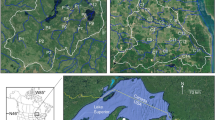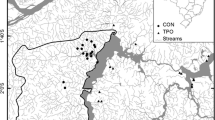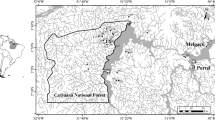Abstract
Mayflies (Insecta: Ephemeroptera) are common inhabitants of streams throughout the Appalachian Mountains. Headwater mayfly assemblages were evaluated with respect to regional landuse disturbances (coal mining and residential) in eastern Kentucky, USA. Estimates of mayfly taxa richness and relative abundance were compared at 92 sites represented by least-disturbed reference (REF; n = 44), residential only (RESID; n = 14), mixed residential and mining (MINED/RESID; n = 14), and mining only (MINED; n = 20) landuse categories. A total of 48 species from 27 genera and 9 families were identified; Ephemerella, Epeorus, Ameletus, Cinygmula, and Paraleptophlebia comprised the core 5 genera most frequently encountered at REF sites. These same genera (among others) were often reduced or extirpated from other landuse categories. Mean mayfly richness and relative abundance were significantly higher at REF sites compared to all other categories; MINED sites had significantly lower metric values compared to RESID and MINED/RESID sites. Relative mayfly abundance was most strongly correlated to specific conductance (r = 0.72) compared to total habitat score (r = 0.59), but relationships varied depending on landuse category. Non-metric multidimensional scaling (for mayfly taxa) and principal components analysis (for environmental variables) separated REF sites strongly from most other sites. The results indicate that expected mayfly communities are disappearing from streams where mining disturbance and residential development has occurred and because of the long-term impacts incurred by both landuses, recovery is uncertain.






Similar content being viewed by others
References
Alexander, L. C., 2007. Genetic diversity and persistence of mayfly populations in disturbed headwater streams. PhD. Dissertation. University of Maryland, College Park, MD.
Barber-James, H. M., J. Gattolliat, M. Sartori & M. D. Hubbard, 2008. Global diversity of mayflies (Ephemeroptera, Insecta) in freshwater. Hydrobiologia 595: 339–350.
Barbour, M. T., J. Gerritsen, B. D. Snyder & J. B. Stribling, 1999. Rapid Bioassessment Protocols for use in Streams and Wadeable Rivers: Periphyton, Benthic Macroinvertebrates, and Fish, Second Edition. EPA 841-B-99-002. U.S. Environmental Protection Agency, Office of Water, Washington, DC.
Bauernfeind, E. & O. Moog, 2000. Mayflies (Insecta: Ephemeroptera) and the assessment of ecological integrity: a methodological approach. Hydrobiologia 422(423): 71–83.
Beketov, M. A., 2004. Different sensitivities of mayflies (Insecta, Ephemeroptera) to ammonia, nitrite and nitrate: linkage between experimental and observational data. Hydrobiologia 528: 209–216.
Blakely, T. J., J. S. Harding, A. R. Mcintosh & M. J. Winterbourn, 2006. Barriers to the recovery of aquatic insect communities in urban streams. Freshwater Biology 51: 1634–1645.
Bodkin, R., J. Kern, P. McClellon, A. J. Butt & C. Martin, 2008. Linking total dissolved solids to protect aquatic life. Journal of Soil & Water Conservation 62: 57–61.
Bond, N. R. & P. S. Lake, 2003. Local habitat restoration in streams: constraints on the effectiveness of restoration for stream biota. Ecological Management and Restoration 4: 193–198.
Braun, E. L., 1950. Deciduous Forests of North America. Hafner, New York, NY.
Bray, J. R. & J. T. Curtis, 1957. An ordination of the upland forest communities in southern Wisconsin. Ecological Monographs 27: 325–349.
Brinkman, S. F. & W. D. Johnston, 2008. Acute toxicity of aqueous copper, cadium, and zinc to the mayfly Rhithrogena hageni. Achives of Environmental Contamination and Toxicology 54: 466–472.
Brittain, J. E. & S. J. Saltveit, 1989. Review of effect of river regulation on mayflies (Ephemeroptera). Regulated Rivers Research and Management 3: 191–204.
Bryant, G., S. McPhilliamy & H. Childers, 2002. A Survey of the Water Quality of Streams in the Primary Region of Mountaintop/valley Fill Coal Mining. Mountaintop Mining/valley Fill Programmatic Environmental Impact Statement. Region 3, US Environmental Protection Agency, Wheeling, WV.
Buchwalter, D. B. & S. N. Luoma, 2005. Differences in dissolved cadmium and zinc uptake among stream insects: mechanistic explanations. Environmental Science and Technology 39: 498–504.
Buchwalter, D. B., D. J. Cain, W. H. Clements & S. N. Luoma, 2007. Using biodynamic models to reconcile differences between laboratory toxicity tests and field biomonitoring with aquatic insects. Environmental Science and Technology 41: 4821–4828.
Buss, D. F. & F. F. Salles, 2007. Using Baetidae species as biological indicators of environmental degradation in a Brazilian River basin. Environmental Monitoring and Assessment 130: 365–372.
Chadwick, M. A., H. Hunter, J. M. Feminella & R. P. Henry, 2002. Salt and water balance in Hexagenia limbata (Ephemeroptera: Ephemeridae) when exposed to brackish water. Florida Entomologist 85: 650–651.
Chambers, D. B. & T. Messer, 2000. Benthic Invertebrate Communities and Their Responses to Selected Environmental Factors in the Kanawha River Basin, West Virginia, Virginia, and North Carolina. Water-Resources Investigations Report 01-4021. US Geological Survey, Charleston, WV.
Clements, W. H., 1994. Benthic invertebrate community responses to heavy metals in the upper Arkansas River Basin, Colorado. Journal of the North American Benthological Society 19: 30–44.
Clements, W. H., 2004. Small-scale experiments support causal relationships between metal contamination and macroinvertebrate community response. Ecological Applications 14: 954–967.
Clements, W. H., D. S. Cherry & J. H. Van Hassel, 1992. Assessment of the impact of heavy metals on benthic communities at the Clinch River (Virginia): evaluation of an index of community sensitivity. Canadian Journal of Fisheries and Aquatic Sciences 49:1686–169.
Courtney, L. A. & W. H. Clements, 2000. Sensitivity to acidic pH in benthic invertebrate assemblages with different histories of metal exposure. Journal of the North American Benthological Society 19: 112–127.
Cuffney, T. F., H. Zappia, E. M. P. Giddings & J. F. Coles, 2005. Effects of urbanization on benthic macroinvertebrate assemblages in contrasting environmental settings: Boston, Massachusetts; Birmingham, Alabama; and Salt Lake City, Utah. American Fisheries Society Symposium 47: 361–407.
Goetsch, P. A. & C. G. Palmer, 1996. Salinity tolerances of selected macroinvertebrates of the Sabie River, Kruger National Park, South Africa. Archives of Environmental Contamination and Toxicology 32: 32–41.
Green J., M. Passmore & H. Childers, 2000. A survey of the condition of streams in the primary region of mountaintop mining/valley fill coal mining. Mountaintop Mining/Valley Fill Programmatic Environmental Impact Statement. U.S. Environmental Protection Agency, Region III. Wheeling, WV. http://www.epa.gov/region3/mtntop/eis2003appendices.htm.
Griffith, M. B., E. M. Barrows & S. A. Perry, 1998. Lateral dispersal of adult aquatic insects (Plecoptera, Trichoptera) following emergence from headwater streams in forested Appalachian catchments. Annals of the Entomological Society of America 91: 195–201.
Haefner, J. D. & J. B. Wallace, 1981. Shifts in aquatic insect populations in a first-order Appalachian stream following a decade of old field succession. Canadian Journal of Fisheries and Aquatic Science. 38: 353–359.
Hartman, K. J., M. D. Kaller, J. W. Howell & J. A. Sweka, 2005. How much do valley fills influence headwater streams? Hydrobiologia 532: 91–102.
Hassell, K. L., B. J. Kefford & D. Nugegoda, 2006. Sub-lethal and chronic salinity tolerances of three freshwater insects: Cloeon sp. and Centroptilum sp. (Ephemeroptera: Baetidae) and Chironomus sp. (Diptera: Chironomidae). Journal of Experimental Biology 209: 4024–4032.
Herlihy, A. T., J. L. Stoddard & C. B. Johnson, 1998. The relationship between stream chemistry and watershed land cover data in the Mid-Atlantic region, US. Water, Air, and Soil pollution 105: 377–386.
Hershey, A. E., J. Pastor, B. J. Peterson & G. J. Kling, 1993. Stable isotopes resolve the drift paradox for Baetis mayflies in an arctic river. Ecology 74: 2415–2425.
Hughes, J., 2007. Constraints on recovery: using molecular methods to study connectivity of aquatic biota in rivers and streams. Freshwater Biology 52: 616–631.
Kennedy, A. J., D. S. Cherry & R. J. Currie, 2003. Field and laboratory assessment of a coal processing effluent in the Leading Creek watershed, Meigs County, Ohio. Archives Environmental Contamination and Toxicology 44: 324–331.
Kentucky Department for Environmental Protection (KYDEP), 2007. Kentucky Administrative Regulations, 401 KAR 5:031 Section 4. Kentucky Department for Environmental Protection, Frankfort, Kentucky. http://www.lrc.ky.gov/kar/401/010/031.htm.
Kentucky Department for Environmental Protection (KYDEP), 2008. Methods for Assessing Biological Integrity of Surface Waters in Kentucky. Kentucky Energy and Environment Cabinet. http://www.water.ky.gov/sw/swmonitor/sop/.
Kondratieff, B. C. (coordinator), 2000. Mayflies of the United States. Northern Prairie Wildlife Research Center Online, Jamestown, ND. Accessed January 7, 2009. http://www.npwrc.usgs.gov/resource/distr/insects/mfly/index.htm (Version 12DEC2003).
Kreutzweiser, D. P., S. S. Capell & K. P. Good, 2005. Macroinvertebrate community response to selection logging and upland areas of headwater catchments in a northern hardwood forest. Journal of the North American Benthological Society 24: 208–222.
Lemly, A. D., 1998. Bacterial growth on stream insects: potential for use in bioassessment. Journal of the North American Benthological Society 17(2): 228–238.
Lemly, A. D., 2000. Using bacterial growth on insects to assess nutrient impacts in streams. Environmental Monitoring and Assessment 63: 431–446.
Masters, Z., I. Petersen, A. G. Hildrew & S. J. Ormerod, 2006. Insect dispersal does not limit the biological recovery of streams from acidification. Aquatic Conservation: Marine and Freshwater Ecosystems 17: 375–383.
McClurg, S. E., J. T. Petty, P. M. Mazik & J. L. Clayton, 2007. Stream ecosystem response to limestone treatment in acid impacted watersheds of the Allegheny Plateau. Ecological Applications 17: 1087–1104.
McCune, B. & J. B. Grace, 2002. Analysis of Ecological Communities. MjM Software Design, Gleneden Beach, OR.
McCune, B. & M. J. Mefford, 1999. Multivariate Analysis of Ecological Data. Version 4.25. MjM Software, Gleneden Beach, OR.
Merricks, T. C., D. S. Cherry, C. E. Zipper, R. J. Currie & T. W. Valenti, 2007. Coal mine hollow fill and settling pond influences on headwater streams in southern West Virginia, USA. Environmental Monitoring and Assessment 129: 359–378.
Moog, O., E. Bauernfeind & P. Weicshelbaumer, 1997. Use of Ephemeroptera as saprobic indicators in Austria. In Landolt, P. & M. Sartori (eds), Ephemroptera and Plecoptera: Biology-Ecology-Systematics. MTL, Fribourg: 254–260.
Morse J. C., B. P. Stark, W. P. McCafferty & K. J. Tennessen, 1997. Southern Appalachian and other southeastern streams at risk: implications for mayflies, dragonflies, stoneflies, and caddisflies. In Benz, G. W. & D. E. Collins (eds), Aquatic Fauna in Peril: The Southeastern Perspective. Special Publication 1, Southeastern Aquatic Research Institute. Lenz Design and Communications, Decatur, GA: 17–42, 554.
Mount, D. R., D. D. Gulley, J. R. Hoickett, T. D. Garrison & J. M. Evans, 1997. Statistical models to predict the toxicity of major ions to Ceriodaphnia dubia, Daphnia magna, and Pimephales promelas (fathead minnows). Environmental Toxicology and Chemistry 16(10): 2009–2019.
NOAA, 2009. http://www.ncdc.noaa.gov/oa/climate/research/drought/palmer-maps/.
Parker, C. R., O. S. Flint, L. M. Jacobs, B. C. Kondratieff, W. P. McCafferty & J. C. Morse, 2007. Ephemeroptera, Plecoptera, Megaloptera, and Trichoptera of Great Smoky Mountains National Park. Southeastern Naturalist Special Issue 1: 159–174.
Paul, M. J. & J. L. Meyer, 2001. Streams in the urban landscape. Annual Review of Ecology and Sytematics 32: 333–365.
Petersen, I., Z. Masters, A. G. Hildrew & S. J. Omerod, 2004. Dispersal of adult aquatic insects in catchment of differing land use. Journal of Applied Ecology 41: 934–950.
Pond G. J. & S. E. McMurray, 2002. A macroinvertebrate bioassessment index for headwater streams in the eastern coalfield region, Kentucky. Kentucky Department for Environmental Protection, Division of Water, Frankfort, KY. http://www.water.ky.gov/NR/rdonlyres/4CA8D7C4-309B-4175-ACC4-1CBDDDF73798/0/EKyMBI.pdf.
Pond G. J., S. C. Call, J. F. Brumley & M. C. Compton, 2003. The Kentucky macroinvertebrate bioassessment index: derivation of regional narrative criteria for headwater and wadeable streams. Kentucky Department for Environmental Protection, Division of Water, Frankfort, KY. http://www.water.ky.gov/NR/rdonlyres/7F189804-4322-4C3E-B267-5A58E48AAD3F/0/Statewide_MBI.pdf.
Pond, G. J., M. E. Passmore, F. A. Borsuk, L. Reynolds & C. J. Rose, 2008. Downstream effects of mountaintop coal mining: comparing biological conditions using genus- and family-level bioassessment tools. Journal of the North American Benthological Society 27: 717–737.
R Development Core Team, 2009. R: A language and environment for statistical computing. R Foundation for Statistical Computing, Vienna, Austria. ISBN 3-900051-07-0. http://www.R-project.org.
Randolph R. P. & W. P. McCafferty, 1998. Diversity and distribution of the mayflies (Ephemeroptera) of Illinois, Indiana, Kentucky, Michigan, Ohio, and Wisconsin. Ohio Biological Survey Bulletin (new series) 13(1): 188 pp.
Reice, S. R., 1985. Experimental disturbance and the maintenance of species diversity in a stream community. Oecologia 67: 90–97.
Slonecker, E. T. & M. J. Benger, 2002. Remote sensing and mountaintop mining. Remote Sensing Reviews 20: 293–322.
Smith, R. F. & W. O. Lamp, 2008. Comparison of insect communities between adjacent headwater and main-stem streams in urban and rural watersheds. Journal of the North American Benthological Society 27: 161–175.
Snyder, C. D. & Z. B. Johnson, 2006. Macroinvertebrate assemblage recovery following a catastrophic flood and debris flows in an Appalachian mountain stream. Journal of the North American Benthological Society 25: 825–840.
Soucek, D. J., 2001. Integrative bioassessment of acid mine drainage impacts on the Upper Powell River watershed, Southwestern Virginia. PhD dissertation. Virginia Polytechnic Institute and State University, Blacksburg, Virginia.
Stone, M. K. & J. B. Wallace, 1998. Long-term recovery of a mountain stream from clear-cut logging: the effects of forest succession on benthic community structure. Freshwater Biology 39: 151–169.
U.S. Environmental Protection Agency, 2005. Mountaintop Mining/Valley Fills in Appalachia, Final Programmatic Environmental Impact Statement. http://www.epa.gov/region3/mtntop/index.htm.
Wallace, J. B., 1990. Recovery of lotic macroinvertebrate communities from disturbance. Environmental Management 14: 605–620.
Wallace, J. B. & M. E. Gurtz, 1986. Response of Baetis mayflies (Ephemeroptera) to catchment logging. American Midland Naturalist 115: 25–41.
Wallace, J. B., M. E. Gurtz & F. Smith-Cuffney, 1988. Long-term comparison of insect abundances in disturbed and undisturbed Appalachian headwater streams. Verhandlungen der Internationalen Vereinigung fur Theoretische und Angewandte Limnologie 23: 1224–1231.
Weijters, M. J., J. H. Janse, R. Alemade & J. T. A. Verhoeven, 2009. Quantifying the effect of catchment land use and water nutrient concentrations on freshwater river and stream biodiversity. Aquatic Conservation: Marine and Freshwater Ecosystems 19: 104–112.
Wellnitz, K. A., S. Grief & S. P. Sheldon, 1994. Response of macroinvertebrates to blooms of iron-depositing bacteria. Hydrobiologia 281: 1–17.
Wickham, J. D., K. H. Riitters, T. G. Wade, M. Coan & C. Homer, 2007. The effect of Appalachian mountaintop mining on interior forest. Landscape Ecology 22: 179–187.
Woods A. J., J. M. Omernik, W. H. Martin, G. J. Pond, W. M. Andrews, S. M. Call, J. A. Comstock & D. D. Taylor, 2002. Ecoregions of Kentucky (2 sided color poster with map, descriptive text, summary tables, and photographs). US Geological Survey (map scale 1:1,000,000), Reston, VA.
Wunsch, D. R., J. S. Dinger, P. B. Taylor, D. I. Carey & C. D. R. Graham, 1996. Hydrogeology, Hydrogeochemistry, and Spoil Settlement at a Large Mine-spoil Area in Eastern Kentucky: Star Fire Tract. Report of Investigations 10, Series XI. Kentucky Geological Survey, University of Kentucky, Lexington, KY.
Acknowledgements
Special thanks for field and laboratory assistance go to present and former KYDEP biologists S. McMurray, M. Compton, D. Peake, R. Pierce, M. Vogel, R. Payne, C. Schneider, J. Brumley, E. Eisiminger, and S. Call. Thanks also to U.S. EPA’s L. Yuan for statistical support and to U.S. EPA’s M. Passmore, L. Alexander, J. Forren, and K. Krock, and KYDEP’s B. Marbert, for providing helpful comments on earlier versions of the manuscript. The final manuscript was improved by R. Bailey and 2 anonymous referees. Views and opinions are those of the author and this manuscript does not necessarily reflect the official views of either the U.S. Environmental Protection Agency or the KY Department for Environmental Protection.
Author information
Authors and Affiliations
Corresponding author
Additional information
Handling editor: Robert Bailey
Rights and permissions
About this article
Cite this article
Pond, G.J. Patterns of Ephemeroptera taxa loss in Appalachian headwater streams (Kentucky, USA). Hydrobiologia 641, 185–201 (2010). https://doi.org/10.1007/s10750-009-0081-6
Received:
Revised:
Accepted:
Published:
Issue Date:
DOI: https://doi.org/10.1007/s10750-009-0081-6




